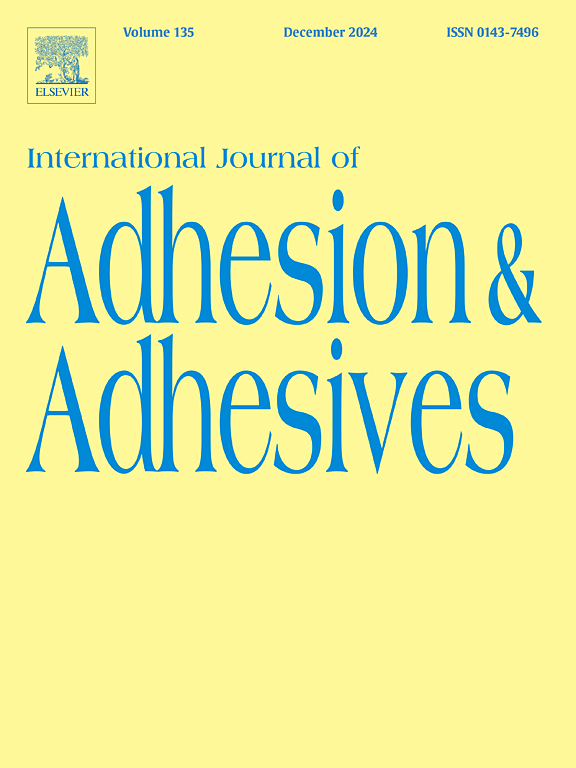低压等离子体和标准表面调理对二硅酸锂和氧化锆陶瓷的比较:体外研究
IF 3.5
3区 材料科学
Q2 ENGINEERING, CHEMICAL
International Journal of Adhesion and Adhesives
Pub Date : 2025-09-18
DOI:10.1016/j.ijadhadh.2025.104159
引用次数: 0
摘要
目的研究低压氧和氩气等离子体处理对陶瓷润湿性、粘结强度和表面特性的影响,并与传统表面处理方法进行比较。材料和方法将二硅酸锂(LS2)和氧化锆(ZR)的圆柱形试样分为三组(每组n = 10):对照组(LS2为氢氟酸蚀刻,ZR为喷砂)、氧等离子体和氩等离子体处理。等离子体处理在低压系统中进行。润湿性通过接触角测量(采用固滴法)来评估,粘接强度通过热循环后的剪切粘接强度(SBS)来测试。利用扫描电镜和x射线光电子能谱分析了表面特征。统计学分析采用ANOVA、Kruskal-Wallis、Student’st检验、Mann-Whitney U检验,显著性P≤0.05。结果等离子体处理显著提高了两种陶瓷的润湿性(p < 0.05)。在LS2中,对照组接触角值最高(50.07±2.70°),氧血浆组最低(12.97±2.16°;p < 0.001)。同样,在ZR中,对照组的接触角最高(55.00±5.96°),氩等离子体的接触角最低(14.75±2.26°;p < 0.001)。LS2组间SBS差异无统计学意义(p = 0.51)。在ZR中,氧血浆组SBS最高(21.32±1.85 MPa),显著高于对照组(13.37±1.88 MPa, p = 0.018)。结论低压氧和氩气等离子体处理可显著提高二硅酸锂和氧化锆陶瓷的润湿性。与传统方法相比,等离子体处理仅在氧化锆中显著增强了结合强度。低压等离子体处理显著提高了二硅酸锂和氧化锆陶瓷的表面润湿性和化学活性,潜在地提高了粘合剂粘合的可靠性,特别是氧化锆。本文章由计算机程序翻译,如有差异,请以英文原文为准。
Comparison of low-pressure plasma and standard surface conditioning on lithium disilicate and zirconia ceramics: An in vitro study
Objective
This study aimed to evaluate the influence of low-pressure oxygen and argon plasma treatments compared to conventional surface conditioning methods on ceramics' wettability, bond strength, and surface characteristics.
Materials and methods
Cylindrical specimens of lithium disilicate (LS2) and zirconia (ZR) were divided into three groups (n = 10 per group): control (hydrofluoric acid etching for LS2 and sandblasting for ZR), oxygen plasma, and argon plasma treatments. Plasma treatments were performed in a low-pressure system. Wettability was assessed by contact angle measurements using the sessile drop method, while bond strength was tested by shear bond strength (SBS) following thermocycling. Surface characteristics were analyzed using Scanning Electron Microscopy and X-ray Photoelectron Spectroscopy. Statistical analyses included ANOVA, Kruskal-Wallis, Student's t-test, and Mann-Whitney U test, with significance set at P ≤ 0.05.
Results
Plasma treatments significantly enhanced the wettability of both ceramics compared to controls (p < 0.05). In LS2, the control group presented the highest contact angle values (50.07 ± 2.70°), while the oxygen plasma group had the lowest (12.97 ± 2.16°; p < 0.001). Similarly, in ZR, the control group exhibited the highest contact angle (55.00 ± 5.96°), and the argon plasma showed the lowest (14.75 ± 2.26°; p < 0.001). No significant differences in SBS were found among LS2 groups (p = 0.51). In ZR, the oxygen plasma group exhibited the highest SBS (21.32 ± 1.85 MPa), significantly greater than the control (13.37 ± 1.88 MPa; p = 0.018).
Conclusion
Low-pressure oxygen and argon plasma treatments significantly improved the wettability of lithium disilicate and zirconia ceramics. Plasma treatment significantly enhanced bond strength only in zirconia compared to conventional methods.
Clinical relevance
Low-pressure plasma treatments significantly enhance the surface wettability and chemical activation of lithium disilicate and zirconia ceramics, potentially improving the reliability of adhesive bonding, especially for zirconia.
求助全文
通过发布文献求助,成功后即可免费获取论文全文。
去求助
来源期刊

International Journal of Adhesion and Adhesives
工程技术-材料科学:综合
CiteScore
6.90
自引率
8.80%
发文量
200
审稿时长
8.3 months
期刊介绍:
The International Journal of Adhesion and Adhesives draws together the many aspects of the science and technology of adhesive materials, from fundamental research and development work to industrial applications. Subject areas covered include: interfacial interactions, surface chemistry, methods of testing, accumulation of test data on physical and mechanical properties, environmental effects, new adhesive materials, sealants, design of bonded joints, and manufacturing technology.
 求助内容:
求助内容: 应助结果提醒方式:
应助结果提醒方式:


